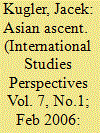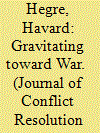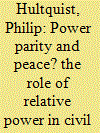| Srl | Item |
| 1 |
ID:
068946


|
|
|
| 2 |
ID:
082936


|
|
|
|
|
| Publication |
2008.
|
| Summary/Abstract |
Countries have better abilities and stronger incentives to engage in militarized conflicts the larger and more powerful they are. The article applies Zipf's notion of a ``gravity model'' to the risk of interstate conflict and argues that the empirical relationship between size and distance and conflict is stronger than any other identified in dyadic statistical studies of interstate conflict. Most empirical studies of interstate conflict fail to take size properly into account. The article shows that controlling for size variables improves the estimation of other variables of interest, and it explores the impact of omitting size variables for the investigation of the power preponderance versus power parity debate. The results indicate that even though a power capability ratio variable suggests asymmetric dyads are less conflict-prone, the risk-increasing effect of power itself means that a unilateral increase of power in one country increases the risk of conflict
|
|
|
|
|
|
|
|
|
|
|
|
|
|
|
|
| 3 |
ID:
124112


|
|
|
|
|
| Publication |
2013.
|
| Summary/Abstract |
Theories of civil war highlight how relative power affects conflict onset, dynamics, strategy, outcome, and duration. Yet most studies of civil war have not been able to capture rebel power adequately and often rely on national-level characteristics to infer relative power distributions. This study addresses this shortcoming by using a troop strength measure to test arguments about how relative power affects the likelihood of civil conflict settlement. Drawing on the international crisis bargaining literature, while noting the inherent differences between interstate and intrastate conflicts, this study argues that the condition of power parity increases the likelihood of negotiated settlement and ceasefire. Weak rebels are unable to achieve concessions through negotiation since governments view them as minor threats. Yet governments have difficulty defeating weak rebels due to an emphasis on guerrilla warfare. On the other end of the spectrum, rebels that are superior to the government in strength are unlikely to settle given their power advantage. Strong rebels that can rival the strength of the government (i.e. they are near parity) can exact more concessions because fighting at parity exposes information about how long each side can hold out while escalating the costs of war, giving each side a greater incentive to negotiate and eventually seek a ceasefire or peace agreement. This argument is supported using data on 112 dyads in the post-Cold War period.
|
|
|
|
|
|
|
|
|
|
|
|
|
|
|
|